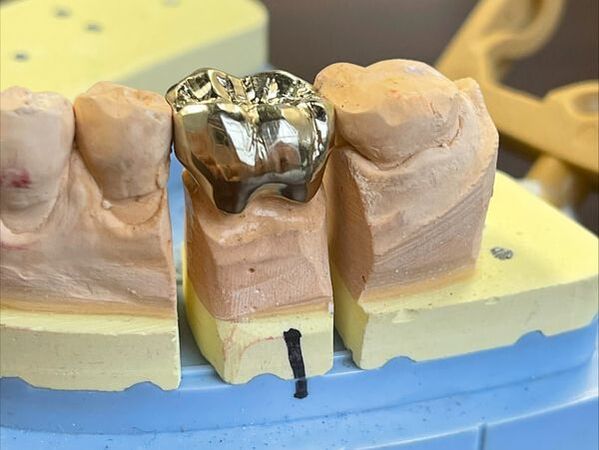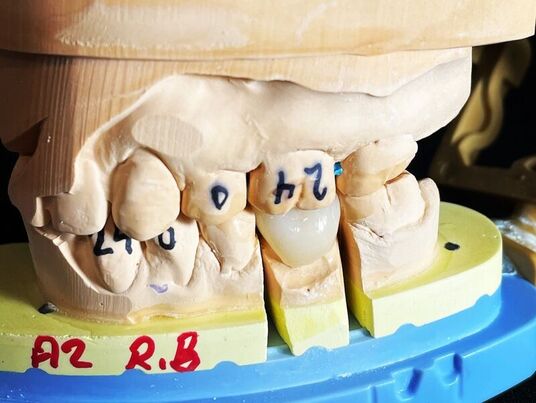CASE ARRIVALAfter the dentist takes the bite impression–either traditionally with alginate or impergum, or digitally with an intraoral scanner, the scan is sent to our lab. Physical cases arrive via mail, Fedex, UPS, or courier, while digital cases arrive via digital portal on the computer. For physical cases, the Shipping and Receiving team are the first to assess the package. The first part of their process is to disinfect each individual case according to OSHA guidelines and as well as assessing for obvious defects in the impression or intraoral scan. Data EntryOnce the case passes through quality control, the data entry team thoroughly enters the details of the case into our software, Atlanta Based Systems Evolution Software. Entering the dentist’s script into our database provides a physical work ticket for our dental technicians to work on. The work ticket details the product, shade, preferences, and the specific schedule for each task to be completed by the doctor's requested due date. While entering the Rx information, our data entry specialists scan in the physical copy of the Rx to reference if needed. Additionally, every case that is entered is photographed, documenting what was received from the doctor. The photograph includes impressions, bite registrations, and parts if included. If the case is a remake, our Client Support and Fulfillment Manager researches the case, consults with the technicians, and documents the plan, reason and what to do to move forward on the case. Modeling and DesignNext, traditional cases arrive at the model department, while digital files go directly to the CAD/CAM department. Depending on whether the case will follow our digital workflow, the case could go forward in the CAD room for scanning and designing or follow our traditional workflow, and in the hands of one of our waxers to start the prosthetic. During the model process, each impression is poured, pinned, articulated and ditched along the margin line. After this occurs, the model is inspected. If anything is found to be troublesome, we then have our technical support team reach out to the dentist to discuss the case. If all is approved by the technician, the case then moves to the next step, whether it is traditional with our wax/invest/cast (substructure team) or scanned and designed with the CAD/CAM team. Prosthesis Fabrication The final design is then milled or printed in house. Prostheses can either be pressed, milled, or casted–depending on the selected material. With our digital workflow, our CAM team is able to load, nest, dry mill, wet mill, or print some of our restorations. For our CAD/CAM process, the design then goes to our Milling team. The case is then nested and fit into our milling blocks, whether it be zirconia, lithium disilicate, or wax. From there the case is milled in its proper material and shade. If the case is milled or printed wax, it will move to the substructure team to be invested and pressed or cast depending on if it is a PFM or lithium disilicate. If the case is a milled zirconia, or lithium disilicate, it then will venture to the next step, fit and contour. Fit and Contour After the milling, printing, pressing or casting is complete, there are different paths to take depending upon the material. If the case is a PFM, once it is casted, it will go to metal finishing. From metal finishing, it then goes to a junior ceramist for degas and opaque. Once that is complete, the case will go to a senior technician, for building porcelain, fitting and contouring, and finishing up with custom staining and glazing. If the case is a full contour zirconia or lithium disilicate, the case is fit and contoured and then sent to our ceramist for final stain and glaze. If the case is a layered zirconia or lithium disilicate, the coping is fit to the model and then the porcelain is built and contoured and finalized with custom staining and glazing. Case DeliveryFinally, the case arrives at Quality Control, where they will further inspect the finished restoration. After passing through quality control, the case is invoiced and shipped to the dentist’s office, where the dentist will inspect the case and check the fit with the patient. They may or may not decide to send the case back to the laboratory for touch-ups. How Can The Dental Lab Help? The Dental Lab strives to provide reliable dental restorations using the most advanced technology in digital dentistry. By marrying aggressive pricing with constant technology, dental technicians, teams, and materials, we are able to create anything from the simplest denture repair to complex implant-supported restoration cases. Call us today to send in your case. Keywords:
The Dental Lab, Dental Lab, Case, Dental Case, Dental restorations, prosthesis, prostheses, dentist, dentists, crown and bridge, pfm, lithium disilicate, zirconia, crowns, dental crowns
0 Comments
Leave a Reply. |



